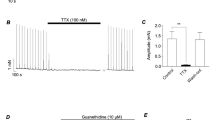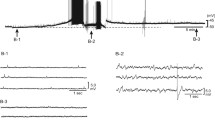Summary
Neurotransmitter release is dependent on influx of Ca2+ through voltage-operated calcium channels (VOCCs). These channels may be divided into L, N, T and P subtypes. To investigate the subtypes of VOCC involved in transmitter release from adrenergic nerves in the isolated rabbit ear artery, the effects of some subtype selective VOCC antagonists were examined on contractile responses induced by electrical field stimulation (EFS), and exposure to an isosmolar (low Na+, normal Cl− content) or a hyperosmolar (normal Na]+, high Cl− or 60 mM K+ solution). Tetrodotoxin (TTX) and the L channel blocker nimodipine were present in the latter experiments to inhibit sodium-dependent action potential discharge and the direct contractile effect of K+ depolarization on the smooth muscle cells. Prazosin abolished the contractile effect of EFS, indicating that the response was elicited by activation of adrenergic nerves. The EFS-induced contractions were concentration-dependently inhibited by the N channel blocker ω-conotoxin (PIC50 = 9.0) and the proposed L channel blocker T-cadinol (pIC50 = 4.5), while nimodipine and the T channel blocker tetramethrin had no effect. The isosmolar and hyperosmolar K+ solutions induced a prazosin-sensitive contraction, amounting to 46% and 10% of the response to 10−5 M noradrenaline (NA), respectively. ω-Conotoxin inhibited the contractile response to the hyperosmolar K+ solution, but not that to the isosmolar K+ solution. T-cadinol preferentially inhibited the response to the hyperosmolar K+ solution. Tetramethrin had no effect on contractions induced by either type of K+ solution. The contractile response to exogenous NA was unaffected by ω-conotoxin and tetramethrin, whereas the response was partially inhibited by both nimodipine and T-cadinol. These results suggest that NA release from adrenergic nerves in the rabbit ear artery, depend on Ca2+ influx through VOCCs of the N type, whereas L and T channels seem to be of minor importance. Calcium influx into the nerve terminals via a tentative Na+/Ca2+ exchange mechanism may explain the failure of ω-conotoxin to inhibit the adrenergic response to the isosmolar K+ solution.
Similar content being viewed by others
References
Ashida T, Blaustein MP (1987) Regulation of cell calcium and contractility in mammalian arterial smooth muscle: the role of sodium-calcium exchange. J Physiol 392:617–635
Bean BP (1989) Classes of calcium channels in vertebrate cells. Annu Rev Physiol 51:367–384
Brock JA, Cunnane TC, Evans RJ, Ziogas J (1989) Inhibition of transmitter release from sympathetic nerve endings by ω-conotoxin. Clin Exp Pharmacol Physiol 16:333–339
Carvalho AP, Bandeira-Duarte C, Ferreira IL, Coutinho OP, Carvalho CM (1991) Sodium-calcium exchange in nerve terminals. Influence on internal Ca 2+ and neurosecretion. Ann N Y Acad Sci 639:300–311
Ceña V, Garcia AG, Khoyi MA, Salaices M, Sanchez-Garcia P (1985) Effect of the dihydropyridine Bay K 8644 on the release of [3H]-noradrenaline from the rat isolated was deferens. Br J Pharmac 85:691–696
Claeson P, Andersson R, Samuelsson G (1991 a) T-cadinol, a pharmacologically active constituent of scented myrrh: introductory pharmacological characterization and high field 3H- and 13C-NMR data. Planta Med 57:352–356
Claeson P, Zygmunt P, Högestätt ED (1991b) Calcium antagonistic properties of the sesquiterpene T-cadinol: a comparison with nimodipine in the isolated rat aorta. Pharmacol Toxicol 69:173–177
Clasbrummel B, Osswald H, Illes P (1989) Inhibition of noradrenaline release by ω-conotoxin GVIA in the rat tail artery. Br J Pharmacol 96:101–110
Feldman DH, Olivera BM, Yoshikami D (1987) Omega Conus geographus toxin: a peptide that blocks calcium channels. FEBS 214:295–300
Godfraind T, Miller R, Wibo M (1986) Calcium antagonism and calcium entry blockade. Pharmacol Rev 38:321–416
Hagiwara N, Irisawa H, Kameyama M (1988) Contribution of two types of calcium currents to the pacemaker potentials of rabbit sino-atrial node cells. J Physiol 395:233–253
Herdon H, Nahorski SR (1989) Investigations of the roles of dihydropyridine and ω-conotoxin-sensitive calcium channels in mediating depolarisation-evoked endogenous dopamine release from striatal slices. Naunyn-Schmiedeberg's Arch Pharmacol 340:36–40
Holz IV GG, Dunlap K, Kream RM (1988) Characterization of the electrically evoked release of substance P from dorsal root ganglion neurons: methods and dihydropyridine sensitivity. J Neurosci 8:463–471
Högestatt ED, Andersson K-E, Edvinsson L (1983) Mechanical properties of rat cerebral arteries as studied by a sensitive device for recording of mechanical activity in isolated small blood vessels. Acta Physiol Scand 117:49–61
Jumblatt JE (1988) Effects of calcium channel antagonists on the depolarization-evoked release of norepinephrine in the rabbit iris-ciliary body. Neurosci Lett 88:286–290
Kaczorowski GJ, Slaughter RS, Garcia ML, King VF (1988) The role of sodium-calcium exchange in excitable cells. Biochem Soc Trans 16:529–532
Kajiwara M, Casteels R (1983) Effects of Ca-antagonists on neuromuscular transmission in the rabbit ear artery. Pflügers Arch 396:1–7
Keith RA, Mangano TJ, Pacheco MA, Salama AI (1989) Characterization of the effects of ω-conotoxin GVIA on the responses of voltage-sensitive calcium channels. J Auton Pharmac 9:243–252
Lundy PM, Frew R (1988) Evidence of ω-conotoxin GVIA-sensitive Ca2+ channels in mammalian peripheral nerve terminals. Eur J Pharmacol 156:325–330
Maggi CA (1991) Omega conotoxin and prejunctional modulation of the biphasic response of the rat isolated urinary bladder to single pulse electrical field stimulation. J Anton Pharmacol 11:295–304
Olivera BM, McIntosh JM, Crus LJ, Luque FA, Gray WR (1984) Purification and sequence of a presynaptic peptide toxin from Conus geographus venom. Biochemistry 23:5087–5090
Owen DG, Segal M, Barker JL (1984) A Ca-dependent Cl− conductance in cultured mouse spinal neurones. Nature 311:567–570
Pan M, Scriabine A, Steinsland OS (1988) Effects of BAY K 8644 on the responses of rabbit ear artery to electrical stimulation. J Cardiovasc Pharmacol 11:127–133
Pruneau D, Angus JA (1990) ω-Conotoxin GVIA is a potent inhibitor of sympathetic neurogenic responses in rat small mesenteric arteries. Br J Pharmacol 100:180–184
Reber BFX, Reuter H (1991) Dependence of cytosolic calcium in differentiating rat pheochromocytoma cells on calcium channels and intracellular stores. J Physiol 435:145–162
Sher E, Clementi F (1991) ω-Conotoxin-sensitive voltage-operated calcium channels in vertebrate cells. Neuroscience 42:301–307
Sher E, Biancardi E, Passafaro M, Clementi F (1991) Physiopathology of neuronal voltage-operated calcium channels. FASEB J 5:2677–2683
Skärby TVC, Hogestatt ED (1990) Differential effects of calcium antagonists and Bay K 8644 on contractile responses to exogenous noradrenaline and adrenergic nerve stimulation in the rabbit ear artery. Br J Pharmacol 101:961–967
Swandulla D, Carbone E, Lux HD (1991) Do calcium channel classifications account for neuronal calcium channel diversity? TINS 14:46–51
Takahashi T, Tsunoda Y, Lu Y, Wiley J, Owyang C (1992) Nicotinic receptor-evoked release of acetylcholine and somatostatin in the myenteric plexus is coupled to calcium influx via N-type calcium channels. J Pharmacol Exp Ther 263:1–5
Tarelli FT, Passafaro M, Clementi F, Sher E (1991) Presynaptic localization of ω-conotoxin-sensitive calcium channels at the frog neuromuscular junction. Brain Res 547:331–334
Thulin M, Claeson P (1991) The botanical origin of scented myrrh (bissabol or habak hadi). Econ Bot 45:487–494
Uski TK, Hogestatt ED, Andersson K-E (1993) Clinical pharmacology of calcium channels. In: Foa PP, Walsh M (eds) Ion channels and ion pumps: Metabolic and endocrine relationships in biology and medicine. Endocrinology and metabolism series, vo1.7. Springer, New York Berlin Heidelberg (in press)
Wagner JA, Guggino SE, Reynolds IJ, Snowman AM, Biswas A, Olivera BM, Snyder SH (1988) Calcium antagonist receptors. Clinical and physiological relevance. Ann NY Acad Sci 522:116–133
Waterson JG, Smale DE (1967) Location of adrenergic structures in the central artery of the rabbit ear. Aust J Exp Biol Med Sci 45:301–308
Wessler I, Dooley DJ, Werhand J, Schlemmer F (1990) Differential effects of calicum channel antagonists (ω-conotoxin GVIA, nifedipine, verapamil) on the electrically-evoked release of [3H]acetylcholine from the myenteric plexus, phrenic nerve and neocortex of rats. Naunyn-Schmiedeberg's Arch Pharmacol 341:288–294
Westenbroek RE, Ahlijanian MK, Catterall WA (1990) Clustering of L-type Ca2+ channels at the base of major dendrites in hippocampal pyramidal neurons. Nature 347:281–284
Yoshii M, Tsunoo A, Narahashi T (1985) Effects of pyrethroids and veratridine on two types of Ca channels in neuroblastoma cells. Soc Neurosci Abstr 11:518
Zygmunt PM, Larsson B, Sterner O, Vinge E, Hogestatt ED (1993) Calcium antagonistic properties of the sesquiterpene T-cadinol and related substances: structure-activity studies. Pharmacol Toxicol (in press)
Author information
Authors and Affiliations
Additional information
Correspondence to P. Zygmunt at the above address
Rights and permissions
About this article
Cite this article
Zygmunt, P.M., Högestätt, E.D. Calcium channels at the adrenergic neuroeffector junction in the rabbit ear artery. Naunyn-Schmiedeberg's Arch Pharmacol 347, 617–623 (1993). https://doi.org/10.1007/BF00166944
Received:
Accepted:
Issue Date:
DOI: https://doi.org/10.1007/BF00166944




